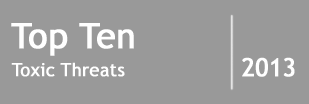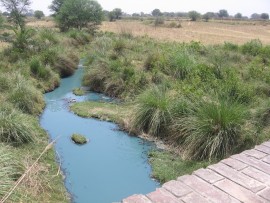Citarum River, Indonesia
Pollutant: Numerous chemicals including lead, cadmium, chromium, and pesticides
Population Affected: 500,000+ people directly, up to 5 million people indirectly
The Citarum River Basin in Bandung, West Java, Indonesia covers an area of approximately 13,000 square kilometers, coming into contact with a population of 9 million people.[1]
The river provides as much as 80% of surface water to Jakarta’s water supply authority, irrigates farms that supply 5% of Indonesia’s rice, and is a source of water for upwards of 2,000 factories.[2]
A range of contaminants are present in the river, from both industrial and domestic sources. Field investigations conducted by Blacksmith Institute, for instance found levels of lead at more than 1,000 times the USEPA standard in drinking water. A 2013 APN Science bulletin found that aluminum, manganese, and iron concentrations in the river were 97 ppb, 195 ppb, and 194 ppb, respectively. These are all significantly higher than the world averages, which are 32 ppb, 34 ppb, and 66 ppb, respectively.[3] The concentrations are also well above the recommended level’s of heavy metals in drinking water set by the EPA. Manganese in drinking water, for example, has a standard of 50 ppb to minimize adverse health effects.[4] Water in the Citarum River has concentrations of manganese that are nearly four times those recommended levels.
Importantly the Indonesian Government is taking considerable action on the issue. As an illustration the government has negotiated a 500 million dollar multi-tranche loan package with the Asian Development Bank to support efforts to rehabilitate Citarum. This will be delivered in 500 million dollar installments over 15 years and is part of the governments 3.5 billion-dollar plan to restore the Citarum.
[1] UNESCO, Citarum River Basin water quality improvement through demonstration of innovative technologies and enhancing capacities at the community, river basin and national levels; November, 2012. Available at: http://www.switch-in-asia.org/Pilot%20sites/SWITCH%20-%20Citarum%20River%20concept%20note_NOV2012_EN.pdf
[2] World Water Week in Stockholm, 2010; Page 31. Available at: http://www.worldwaterweek.org/documents/Resources/Synthesis/Abstract_Volume_2010.pdf
[3] Asia-Pacific Network for Global Change Research, Issue 3, March 2013. Available at: http://abs.aseanbiodiversity.org/images/documents/APN%20Science%20Bulletin%20-%20March%202013.pdf#page=8
[4] EPA: Secondary Drinking Water Regulations, 2013. Available at: http://water.epa.gov/drink/contaminants/secondarystandards.cfm




